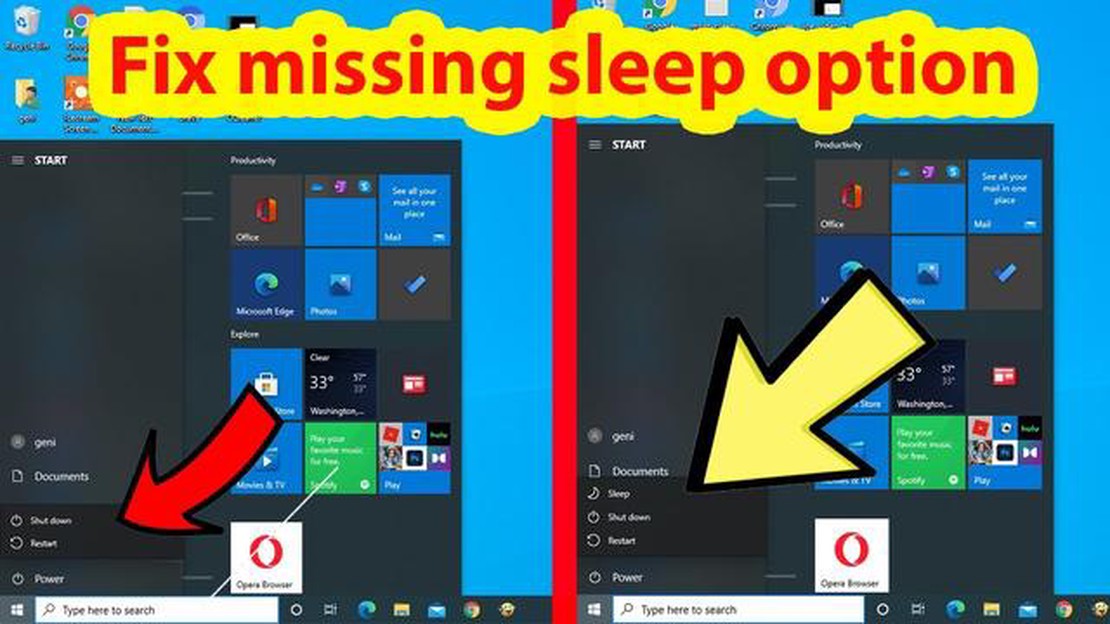chrome 78: sites can edit local files and read otp sms
Latest versions of chrome 78 allow sites to edit local files, read otp sms and more The latest version of Google’s Chrome 78 browser has made several …
Read Article
The sleep mode in Windows 10 operating system provides a convenient way to save the current state of your computer and quickly resume work at any time. This is especially useful when you need to temporarily interrupt your work or walk away from your computer without closing applications or shutting it down completely. Before you can start using sleep mode, you need to activate it on your computer.
Activating sleep mode in Windows 10 is quite simple. You will need to open the Start menu, then go to Settings. In this section, find and select “System”. Next, go to “Power and Hibernation” where you will have access to the sleep settings and options.
In the “Power and Hibernation” section, you can set the idle time of your computer after which the operating system will automatically activate sleep mode. This is also where you can set the screen fade mode or prohibit the computer from automatically hibernating during battery life. Select the settings that suit your needs and click “Apply”.
Now that sleep mode is activated, you can click on the Start button at any time and select “Sleep” or “Hibernate” to go straight to the saved state of your computer. In sleep mode, all work and applications will remain open and the computer will consume minimal power. Once you activate resume your computer, you will be able to pick up where you left off.
Sleep mode is a special mode of operation that allows your computer to go into a low power state when not in use. This is useful when you want to temporarily interrupt your work and conserve your computer’s energy. In Windows 10, there are several ways to activate sleep mode.
1. Using the Start menu:
2. Using the keyboard shortcut:
Press the keyboard shortcut Win + X, and then select “Power and Sleep” from the context menu. Then select “Sleep.”
Read Also: Amazon is gearing up to launch a streaming gaming service
3. Using the power settings:
That was a complete guide on how to enable sleep mode in Windows 10. Make sure you have enough time before your computer goes to sleep before activating this feature. Otherwise, you might lose unsaved information.
Sleep mode in Windows 10 allows your computer to conserve energy and go into sleep mode when not in use. This is a useful feature that allows you to resume work quickly without losing data and settings.
Here are the step-by-step instructions to activate sleep mode in Windows 10:
To manually put the computer into sleep mode, you can use the following steps:
Now you know how to activate sleep mode in Windows 10 and how to manually put your computer into this mode. Use this feature to save energy and resume work quickly on your Windows 10 computer.
Read Also: How To Resolve HBO Max Not Working On Firestick Issue - Quick Guide
To activate sleep mode in Windows 10, you need to open the Start menu and click on the “Power” button. Then select the “Sleep” option and click on it. Now your computer will go into sleep mode.
If the Sleep button is missing from the Power menu, it may have been hidden due to your power settings. To see this button, you need to go into the power settings. Open “Control Panel,” select “Power,” and click on “Select Power Button Action.” Then in the “Select the action your computer takes when you close the lid” menu, select “Sleep”. The “Sleep” button should then appear in the power menu.
Yes, you can customize sleep mode for only one user on a Windows 10 computer. To do so, go to Settings > System > Power & Sleep and select the settings you want for that user. The other users will use the general power settings.
To change the time after which the computer goes to sleep, go to Settings > System > Power & Sleep and find the Sleep section. In this section, you can choose the delay time before sleep for your computer, laptop, or connected display. Simply move the slider to the position you want.
Yes, you can disable sleep mode in Windows 10. To do so, go to Settings > System > Power & Sleep and find the Sleep section. In this section, select the “Never” option from the list of Display Off and Standby. After that, the computer will not go into sleep mode.
To activate sleep mode in Windows 10, you can simply close the lid of your laptop (if you have one) or click the Start button in the bottom left corner of the screen, select the power icon and then click “Sleep”. You can also press the spacebar on your keyboard and select “Sleep” from the Start menu.
Latest versions of chrome 78 allow sites to edit local files, read otp sms and more The latest version of Google’s Chrome 78 browser has made several …
Read ArticleHow to remove qidion adware from browser? The qidion adware is unwanted software that can infiltrate your browser and display annoying advertisements. …
Read ArticleHow To Fix Cant Eject External Hard Drive On Windows 10 If you are experiencing difficulties ejecting your external hard drive on Windows 10, you are …
Read ArticleHow To Fix MultiVersus Connection Lost Issue MultiVersus is a popular online multiplayer game that offers gamers the chance to face off against each …
Read ArticleConnection problems in saints row co-op game Cooperative mode games are becoming increasingly popular among players. They allow people to spend time …
Read Article5 Best MicroSD Memory Card For Nintendo Switch The Nintendo Switch is a versatile gaming console that allows you to play games both in handheld mode …
Read Article